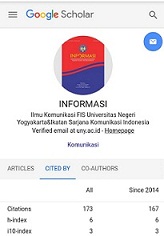Parenting and sharenting communication for preventing juvenile delinquency
DOI:
https://doi.org/10.21831/informasi.v50i2.36847Keywords:
Communication, Parenting, Sharenting, Delinquency, AdolescenceAbstract
The focus of this research is to examine the communication techniques between parents and children in the context of parenting and giving advice (sharenting) for the prevention of children or adolescents' delinquency. The informants of this research were students, teachers, parents, and community leaders from two countries (Indonesia and Malaysia). Data were collected utilizing the focus group discussion techniques via Zoom meeting platform. Data were analyzed using interactive analysis which includes four stages, namely: data collection, data reduction, display data, and drawing a conclusion/verification. The results show that parenting and sharenting communication are strategic forums to guide adolescents to avoid various forms of deviant behavior, especially delinquency. The communication techniques applied consist of persuasive and in certain conditions coercive communication techniques are utilized. Communication barriers include the lack of commitment of some parents in carrying out comprehensive communication.
References
Aini, L. N. (2017). Hubungan pola asuh orang tua dengan kenakalan remaja di RW V Kelurahan Sidokare Kecamatan Sidoarjo. Jurnal Keperawatan dan Kebidanan, 6(1). 211-224.
Alavi, K., & Mahbob, M. H. (2017). Komunikasi berkesan dengan warga emas: Dari perspektif intervensi kerja sosial. Jurnal Komunikasi, Malaysian Journal of Communication, 33(4). 21-37. doi: https://doi.org/10.17576/JKMJC-2017-3304-02
Aw, S. (2019). The failure of persuasive communication among social workers in mentoring street children. Jurnal Komunikasi: Malaysian Journal of Communication, 35(2). 161-175. doi: https://doi.org/10.17576/JKMJC-2019-3502-10
Aw, S., Hajaroh, M., & Hastasari, C. (2020, February). Preventing student delinquency through three education center communication. In International Conference on Educational Research and Innovation (ICERI 2019) (pp. 311-313). Atlantis Press. doi: https://doi.org/10.2991/assehr.k.200204.059
Blum-Ross, A., & Livingstone, S. (2017). "Sharenting," parent blogging, and the boundaries of the digital self. Popular Communication, 15(2), 110-125. doi: https://doi.org/10.1080/15405702.2016.1223300
Choi, G. Y., & Lewallen, J. (2018). "Say Instagram, Kids!": Examining sharenting and children's digital representations on Instagram. Howard Journal of Communications, 29(2), 144-164. doi: https://doi.org/10.1080/10646175.2017.1327380
Creswell, J. W. (2014). Research design: Qaualitative, quantitative, and mixed methods approaches (4th ed.). London: Sage.
Davis, N. O., & Carter, A. S. (2008). Parenting stress in mothers and fathers of toddlers with autism spectrum disorders: Associations with child characteristics. Journal of autism and developmental disorders, 38(7), 1278–1291. doi: https://doi.org/10.1007/s10803-007-0512-z
Denzin, N. K., & Lincoln, Y. S. (2003). O involved in the study of social problems. Handbook of social problems: A comparative international perspective, 30.
Effendy, O.U. (1986). Dinamika komunikasi. Bandung: PT Remaja Rosdakarya.
Hovland, C. I., Janis, I. L., & Kelley, H. H. (1983). Communication and persuasion; Psychological studies of opinion change. Yale University Press.
Krech, D., Crutchfield, R.S., & Ballachey, E. (1972) Individual in society. McGraw Hill Book Company.
Keen, D., Couzens, D., Muspratt, S., & Rodger, S. (2010). The effects of a parent-focused intervention for children with a recent diagnosis of autism spectrum disorder on parenting stress and competence. Research in Autism Spectrum Disorders, 4(2), 229-241. doi: https://doi.org/10.1016/j.rasd.2009.09.009
Klein, V., Becker, I., & Å tulhofer, A. (2018). Parenting, communication about sexuality, and the development of adolescent womens' sexual agency: A longitudinal assessment. Journal of youth and adolescence, 47(7), 1486-1498. doi: https://doi.org/10.1007/s10964-018-0873-y
Kurniawan, D. (2018). Komunikasi model laswell dan stimulus-organism-response dalam mewujudkan pembelajaran menyenangkan. Jurnal Komunikasi Pendidikan, 2(1), 60-68. doi: https://doi.org/10.32585/jkp.v2i1.65
Locker, K. O., & Kienzler, D. S. (2013). Business and administrative communication. McGraw-Hill.
Manaf, A. M. A., Taibi, M., & Manan, K. A. (2017). Media agenda and public agenda: A study of issues during the 13th general election. Jurnal Komunikasi: Malaysian Journal of Communication, 33(2). 13-26. doi: https://doi.org/10.17576/JKMJC-2017-3302-02
Miles, M. B., Huberman, A. M., Huberman, M. A., & Huberman, M. (1994). Qualitative data analysis: An expanded sourcebook. London: Sage.
Muawanah, L. B. (2012). Kematangan emosi, konsep diri dan kenakalan remaja. Persona: Jurnal Psikologi Indonesia, 1(1). 6-14. doi: https://doi.org/10.30996/persona.v1i1.9
Patton, M. Q. (2005). Qualitative research. Encyclopedia of statistics in behavioral science.
Rahmat, J. (2001). Psikologi komunikasi. Bandung: PT. Remaja Rosdakarya.
Rosiana, K. (2017). Teknik komunikasi koersif dinas kesejahteraan sosial dalam menanggulangi gelandangan dan pengemis di Kota Samarinda. eJournal Ilmu Komunikasi, 2017, 5 (4):109-118
Siibak, A., & Traks, K. (2019). The dark sides of sharenting. Catalan Journal of Communication & Cultural Studies, 11(1), 115-121. doi: https://doi.org/10.1386/cjcs.11.1.115_1
Sulaiman, I.A. (2013). Model komunikasi formal dan informal dalam proses kegiatan pemberdayaan masyarakat. Jurnal Penelitian Komunikasi. 6(2). 231-242.
Sumara, D.S., Humaedi, S., & Santoso., M. B. (2017). Kenakalan remaja dan penanganannya. Prosiding Penelitian dan Pengabdian kepada Masyarakat, 4(2). 346-347. doi: https://doi.org/10.24198/jppm.v4i2.14393
Tubbs, S. & Moss, S. (2001). Human communication konteks-konteks komunikasi. diterjemahkan oleh Dedy Mulyana. Bandung: PT Remaja Rosdakarya.
Unayah, N., & Sabarisman, M. (2016). Fenomena kenakalan remaja dan kriminalitas. Sosio informa, 1(2). 121-140.
Downloads
Published
How to Cite
Issue
Section
Citation Check
License
Authors who publish with this journal agree to the following terms:- Authors retain copyright and grant the journal right of first publication with the work simultaneously licensed under a Creative Commons Attribution License that allows others to share the work with an acknowledgement of the work's authorship and initial publication in this journal.
- Authors are able to enter into separate, additional contractual arrangements for the non-exclusive distribution of the journal's published version of the work (e.g., post it to an institutional repository or publish it in a book), with an acknowledgement of its initial publication in this journal.
- Authors are permitted and encouraged to post their work online (e.g., in institutional repositories or on their website) prior to and during the submission process, as it can lead to productive exchanges, as well as earlier and greater citation of published work (See The Effect of Open Access).


























